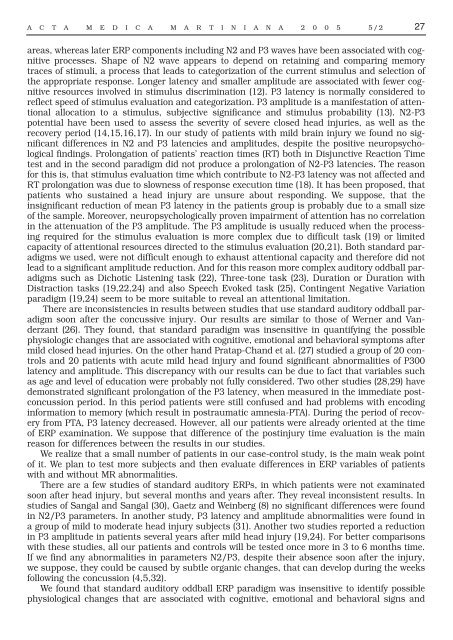MAKETA 5/2 po
MAKETA 5/2 po
MAKETA 5/2 po
Create successful ePaper yourself
Turn your PDF publications into a flip-book with our unique Google optimized e-Paper software.
A C T A M E D I C A M A R T I N I A N A 2 0 0 5 5/2 27<br />
areas, whereas later ERP com<strong>po</strong>nents including N2 and P3 waves have been associated with cognitive<br />
processes. Shape of N2 wave appears to depend on retaining and comparing memory<br />
traces of stimuli, a process that leads to categorization of the current stimulus and selection of<br />
the appropriate res<strong>po</strong>nse. Longer latency and smaller amplitude are associated with fewer cognitive<br />
resources involved in stimulus discrimination (12). P3 latency is normally considered to<br />
reflect speed of stimulus evaluation and categorization. P3 amplitude is a manifestation of attentional<br />
allocation to a stimulus, subjective significance and stimulus probability (13). N2-P3<br />
<strong>po</strong>tential have been used to assess the severity of severe closed head injuries, as well as the<br />
recovery period (14,15,16,17). In our study of patients with mild brain injury we found no significant<br />
differences in N2 and P3 latencies and amplitudes, despite the <strong>po</strong>sitive neuropsychological<br />
findings. Prolongation of patients’ reaction times (RT) both in Disjunctive Reaction Time<br />
test and in the second paradigm did not produce a prolongation of N2-P3 latencies. The reason<br />
for this is, that stimulus evaluation time which contribute to N2-P3 latency was not affected and<br />
RT prolongation was due to slowness of res<strong>po</strong>nse execution time (18). It has been pro<strong>po</strong>sed, that<br />
patients who sustained a head injury are unsure about res<strong>po</strong>nding. We sup<strong>po</strong>se, that the<br />
insignificant reduction of mean P3 latency in the patients group is probably due to a small size<br />
of the sample. Moreover, neuropsychologically proven impairment of attention has no correlation<br />
in the attenuation of the P3 amplitude. The P3 amplitude is usually reduced when the processing<br />
required for the stimulus evaluation is more complex due to difficult task (19) or limited<br />
capacity of attentional resources directed to the stimulus evaluation (20,21). Both standard paradigms<br />
we used, were not difficult enough to exhaust attentional capacity and therefore did not<br />
lead to a significant amplitude reduction. And for this reason more complex auditory oddball paradigms<br />
such as Dichotic Listening task (22), Three-tone task (23), Duration or Duration with<br />
Distraction tasks (19,22,24) and also Speech Evoked task (25), Contingent Negative Variation<br />
paradigm (19,24) seem to be more suitable to reveal an attentional limitation.<br />
There are inconsistencies in results between studies that use standard auditory oddball paradigm<br />
soon after the concussive injury. Our results are similar to those of Werner and Vanderzant<br />
(26). They found, that standard paradigm was insensitive in quantifying the <strong>po</strong>ssible<br />
physiologic changes that are associated with cognitive, emotional and behavioral symptoms after<br />
mild closed head injuries. On the other hand Pratap-Chand et al. (27) studied a group of 20 controls<br />
and 20 patients with acute mild head injury and found significant abnormalities of P300<br />
latency and amplitude. This discrepancy with our results can be due to fact that variables such<br />
as age and level of education were probably not fully considered. Two other studies (28,29) have<br />
demonstrated significant prolongation of the P3 latency, when measured in the immediate <strong>po</strong>stconcussion<br />
period. In this period patients were still confused and had problems with encoding<br />
information to memory (which result in <strong>po</strong>straumatic amnesia-PTA). During the period of recovery<br />
from PTA, P3 latency decreased. However, all our patients were already oriented at the time<br />
of ERP examination. We sup<strong>po</strong>se that difference of the <strong>po</strong>stinjury time evaluation is the main<br />
reason for differences between the results in our studies.<br />
We realize that a small number of patients in our case-control study, is the main weak <strong>po</strong>int<br />
of it. We plan to test more subjects and then evaluate differences in ERP variables of patients<br />
with and without MR abnormalities.<br />
There are a few studies of standard auditory ERPs, in which patients were not examinated<br />
soon after head injury, but several months and years after. They reveal inconsistent results. In<br />
studies of Sangal and Sangal (30), Gaetz and Weinberg (8) no significant differences were found<br />
in N2/P3 parameters. In another study, P3 latency and amplitude abnormalities were found in<br />
a group of mild to moderate head injury subjects (31). Another two studies re<strong>po</strong>rted a reduction<br />
in P3 amplitude in patients several years after mild head injury (19,24). For better comparisons<br />
with these studies, all our patients and controls will be tested once more in 3 to 6 months time.<br />
If we find any abnormalities in parameters N2/P3, despite their absence soon after the injury,<br />
we sup<strong>po</strong>se, they could be caused by subtle organic changes, that can develop during the weeks<br />
following the concussion (4,5,32).<br />
We found that standard auditory oddball ERP paradigm was insensitive to identify <strong>po</strong>ssible<br />
physiological changes that are associated with cognitive, emotional and behavioral signs and

















